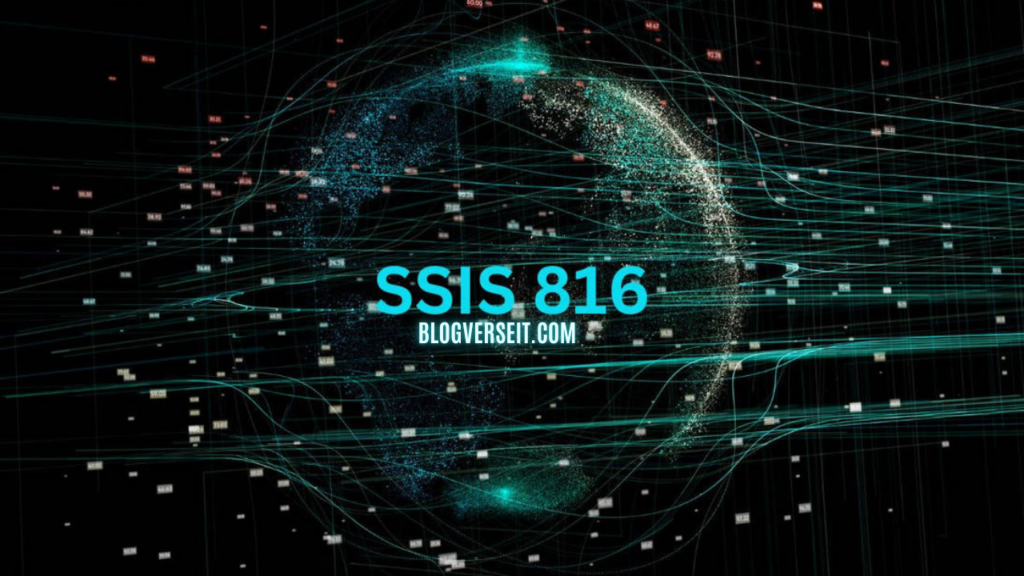Introduction
SSIS 816 is a feature within SQL Server Integration Services (SSIS) designed to streamline data integration and migration processes for businesses. It automates the extraction, transformation, and loading (ETL) of data from various sources, enhancing efficiency and accuracy in managing large volumes of information. Key capabilities of SSIS 816 include robust error handling, support for multiple data sources, and built-in scheduling tools for automating repetitive tasks. By simplifying complex data management tasks, SSIS 816 helps organizations optimize their operations and ensures real-time data updates for better decision-making.
What is SSIS-816?
SSIS-816 stands as a critical component in the realm of SQL Server Integration Services. It represents a specific version or update designed to enhance the overall capabilities of SSIS packages. An SSIS package is essentially a collection of workflows, data flows, and control flows, allowing users to extract, transform, and load (ETL) data from various sources into databases or other destinations.
With SSIS-816, several performance improvements and additional features were introduced to help businesses and developers handle large volumes of data efficiently. It automates many complex tasks, making data manipulation faster and easier.
The Purpose of SSIS-816
SSIS-816 enables users to handle a wide range of data integration scenarios, from simple data transfers between databases to complex transformations. Businesses rely on SSIS-816 to clean and reshape data, thus allowing them to make sense of large datasets and ensure data consistency across multiple systems.
Without SSIS-816, data professionals would face significant challenges, including handling data inaccuracies, slow processing times, and manual ETL tasks. This SSIS update specifically addresses these concerns by improving the overall workflow of SQL Server Integration Services, providing better performance, scalability, and reliability.
Core Features of SSIS-816
SSIS-816 comes packed with advanced features aimed at simplifying data integration:
Improved Data Transformation:
SSIS-816 introduces advanced transformation options, allowing developers to clean, aggregate, and merge data more effectively. This enhancement ensures seamless integration of structured and unstructured data sources.
Performance Optimization:
With this update, the system optimizes resource usage, reducing processing times for large datasets. It achieves this through parallel execution and refined data flow mechanisms.
Error Handling and Logging:
In SSIS-816, error-handling capabilities allow users to capture and fix issues quickly during data flow operations. Enhanced logging ensures traceability and accountability in data processes.
Integration with Azure:
SSIS-816 supports cloud-based operations through Azure, allowing businesses to easily integrate on-premise data with cloud services.
Improved User Interface:
The graphical user interface in SSIS-816 makes it easier for developers to design and manage ETL workflows with minimal coding.
Why Choose SSIS-816 for Data Integration?
Choosing SSIS-816 offers many advantages for both small and large organizations. From simplifying ETL processes to ensuring the integrity and accuracy of data, SSIS-816 is built for the modern data ecosystem.
Scalability:
As businesses grow, the need for more complex data management arises. SSIS-816 scales with your business, providing robust data integration capabilities to manage increasing volumes of data.
Cost-Efficiency:
Using SQL Server Integration Services (and SSIS-816 in particular) eliminates the need for expensive third-party ETL tools. It integrates natively with Microsoft SQL Server, saving both time and money.
User-Friendly Interface:
The drag-and-drop interface ensures that even users with minimal coding knowledge can set up and execute SSIS packages. SSIS-816 builds upon this, offering a more intuitive experience.
Cross-Platform Connectivity:
With SSIS-816, users can connect to various data sources, including SQL Server, Oracle, flat files, and cloud-based platforms like Azure and Amazon S3. This flexibility ensures that businesses can move data seamlessly between systems.
How to Get Started with SSIS-816
If you are new to SSIS-816 or upgrading from a previous version, getting started involves a few key steps.
Installing SQL Server and SSIS:
To use SSIS-816, you need a working installation of Microsoft SQL Server. Depending on your setup, you may need to install the latest version or update your existing installation to the SSIS-816 version.
Creating Your First SSIS Package:
Open SQL Server Data Tools (SSDT), which provides the environment for creating, debugging, and deploying SSIS packages. Begin by selecting your source data and designing the control flow, then proceed to define the data flow tasks and transformations.
Deploying Your SSIS Package:
After creating your package, deploy it to your SQL Server or Azure environment. SSIS-816 allows for easier integration with cloud platforms, so you can run your package in the cloud if needed.
Best Practices for Using SSIS-816
For those aiming to get the most out of SSIS-816, following a few best practices can ensure optimal performance and maintainability:
Organize Your Packages:
Always name and organize your SSIS packages clearly. This helps in long-term maintenance and makes it easier for teams to collaborate on projects.
Optimize Data Flows:
SSIS-816 excels at optimizing performance, but developers should ensure that data flows are streamlined. This includes limiting transformations in the data flow, choosing appropriate data types, and using parallel execution where possible.
Monitor and Log Performance:
Make use of the enhanced logging and monitoring features within SSIS816 to track performance and troubleshoot any issues that arise during ETL processes.
Test Thoroughly:
Before deploying any SSIS package, conduct thorough testing in a controlled environment. This ensures that the data flows as expected and that there are no surprises in production.
Utilize Error Handling:
Error handling is essential in any data integration task. SSIS816 allows for more detailed error handling, enabling you to address issues without disrupting the entire workflow.
Common Challenges and How SSIS-816 Solves Them
When working with data integration tools, challenges often arise. SSIS-816 addresses many common issues that data professionals encounter:
Data Latency:
SSIS816 optimizes the data processing pipeline, ensuring faster data transfer even for large datasets. Its improved parallelism significantly reduces latency.
Data Inconsistency:
By using the built-in data transformation features, SSIS816 ensures that data is cleaned and standardized before loading it into a target system.
Security Concerns:
SSIS816 supports secure connections to data sources and ensures that sensitive information is encrypted during transit.
Error Tracking:
The enhanced logging and error-handling mechanisms in SSIS816 make it easier to identify and fix issues, minimizing downtime in production environments.
Real-World Applications of SSIS816
SSIS-816 has wide-ranging applications in various industries. From e-commerce to finance, businesses rely on this tool to manage their data effectively.
Retail and E-Commerce:
In the retail sector, SSIS816 can integrate data from sales, inventory, and customer relationship systems to provide a 360-degree view of the business.
Healthcare:
Healthcare providers use SSIS-816 to manage patient records and integrate data across multiple systems, ensuring accuracy and compliance with health regulations.
Financial Services:
Banks and financial institutions employ SSIS-816 to handle large volumes of transaction data, ensuring data integrity and enabling real-time reporting.
Manufacturing:
SSIS816 can integrate data from production lines, inventory systems, and ERP platforms to ensure streamlined operations.
Advanced Features to Explore in SSIS816
As users grow more comfortable with SSIS816, they can explore some of its more advanced features:
Custom Script Tasks:
SSIS816 allows developers to write custom C# or VB.NET scripts for more complex data transformations.
Dynamic Data Loading:
Using parameters, SSIS816 can dynamically load data based on user input or external conditions, providing flexibility in data processing workflows.
Data Encryption:
The ability to encrypt data during transit ensures that sensitive information is protected, making SSIS816 a strong choice for industries that deal with confidential data.
How SSIS816 Compares to Other ETL Tools
In the world of data integration, several ETL tools are available, each with its strengths. SSIS816 competes with tools like Talend, Informatica, and Apache Nifi. What sets SSIS816 apart?
Cost-Effectiveness:
As a built-in component of SQL Server, SSIS816 comes at no additional cost to SQL Server users. Other ETL tools often require hefty licensing fees.
Ease of Use:
The drag-and-drop interface makes SSIS816 easier to learn compared to other tools that might require more coding experience.
Integration with Microsoft Ecosystem:
SSIS816 integrates seamlessly with other Microsoft products like Azure, Excel, and Power BI, providing a cohesive experience for businesses already invested in the Microsoft stack.
Conclusion
SSIS816 revolutionizes the way businesses approach data integration, providing a robust and scalable solution for managing complex ETL processes. From its user-friendly interface to its advanced error-handling capabilities, SSIS816 is designed to empower organizations with the tools they need to succeed in a data-driven world. By following best practices, optimizing data flows, and leveraging the power of SSIS816, businesses can unlock the full potential of their data and achieve operational excellence. Whether you are new to SQL Server Integration Services or an experienced data professional, SSIS-816 offers the versatility, performance, and ease of use required for modern data challenges.
Also Read: Jablw.rv: Recreational Vehicle Experience for Ultimate Adventure
FAQs
What is SSIS816 used for?
SSIS816 is a version of SQL Server Integration Services that is used for data extraction, transformation, and loading (ETL) processes. It automates complex data integration tasks.
How do I upgrade to SSIS816?
Upgrading to SSIS816 requires updating your SQL Server installation to the latest version that supports this SSIS release. Follow Microsoft’s documentation for step-by-step instructions.
Can I use SSIS816 with Azure?
Yes, SSIS816 integrates well with Microsoft Azure. You can deploy your SSIS packages to Azure Data Factory and run them in the cloud.
Does SSIS816 support custom scripts?
Yes, SSIS816 supports custom scripts written in C# or VB.NET, allowing for more complex data transformations beyond the built-in functionality.
Is SSIS816 suitable for real-time data integration?
While SSIS is traditionally used for batch processing, SSIS-816 can handle near-real-time integration scenarios by utilizing event-driven data flows.







